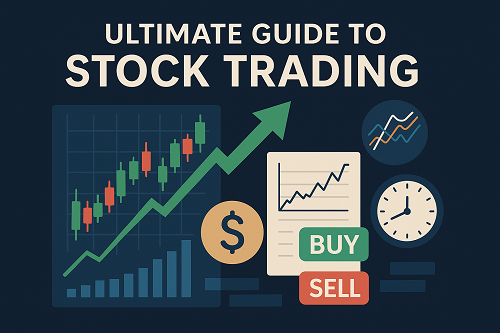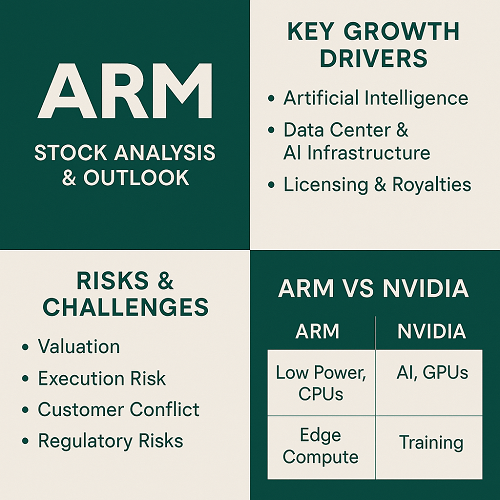Why Stock Trading Matters
Stock trading is more than just buying shares — it’s an active strategy to extract short- to medium-term gains using volatility, patterns, and market inefficiencies. Unlike long-term investing, trading demands discipline, quick decision-making, and a codified edge.
What you’ll get by mastering this guide:
- Clear, jargon-free foundational knowledge
- Actionable setups, rules, and methods you can test
- Insights from psychology, risk, and systemic thinking
- Tools to reduce drawdowns and enhance consistency
By the time you finish, you’ll have both theory and practical wisdom to execute trades with significantly better odds.
Core Concepts & Terminology
What Is Stock Trading?
Stock trading means buying and selling equity shares with the aim of profiting from price movements over shorter timeframes, often ranging from minutes to months. It differs from buy-and-hold investing in that you’re not banking solely on dividends or long-term growth but rather capitalizing on fluctuations.
Long vs. Short Positions
- Long: You own shares, expecting price to rise.
- Short: You borrow shares and sell them now to repurchase later at a lower price (if correct), profiting from declines.
Order Types
| Order Type | Definition | Use & Risk |
|---|---|---|
| Market Order | Execute immediately at best available price | Simple but may incur slippage |
| Limit Order | Set max price to buy or min price to sell | Precise control, but may not fill |
| Stop Order | Becomes market order when price passes “stop” | For protection / breakout trades |
| Stop-Limit Order | Becomes a limit order after stop is triggered | More control, but risk of non-execution |
Understanding how order types interact with liquidity and volatility is vital.
Bid, Ask, Spread & Liquidity
- Bid: Highest price someone is willing to pay
- Ask (Offer): Lowest price someone is willing to sell
- Spread: Ask minus Bid — a cost to cross the spread
- Liquidity: Depth of buyers/sellers — tighter spreads, better fills
In illiquid stocks, you might face large price slippage or partial fills.
Volume, Market Depth & Order Book
Volume tells you how active a stock is. Order book depth shows how many shares are waiting at various price levels. A price bump through a thick order block is meaningful (support/resistance).
Market Structure & Exchanges
Major Exchanges
The New York Stock Exchange (NYSE) and NASDAQ dominate U.S. cash equities. In Canada, the TSX is central. Each has its rules on settlement (T+2), listing standards, and circuit breakers.
OTC & Dark Pools
Some stocks trade over-the-counter (OTC) outside major exchanges — higher risk, lower transparency. Dark pools are off-exchange venues where large blocks trade away from public order books, sometimes affecting price discovery.
Market Participants
- Retail Traders — individuals
- Institutional Investors — mutual funds, hedge funds, pension, etc.
- Market Makers / Specialists — provide liquidity, narrow spreads
- Proprietary Trading Firms — algorithmic / high-frequency operations
Knowing who you’re competing with helps shape realistic expectations.
Types of Stock Trading Styles
No “one style fits all” — successful traders often pick one or two that match their temperament, capital, and time.
Day Trading
All trades opened and closed within the same day. No overnight exposure. Very fast pace, high cost of mistakes.
Swing Trading
Holding for days to weeks to capture intermediate trends. Requires less constant attention than day trading.
Position Trading
Holding positions for several weeks to months. Intermediate between investing and trading.
Momentum & Trend Trading
Buy when trend is strong, ride it until exhaustion. Use volume and breakout confirmation.
Algorithmic / Quantitative Trading
Rules-based strategies executed automatically — e.g., mean reversion, statistical arbitrage, factor models.
How to Get Started: Setup & Tools
Choosing a Broker & Platform
- Low commissions / fees
- Fast execution & minimal latency
- Access to order types and margin
- Reliable charting tools
- Mobile access & API (for automation)
Check regulatory safety (e.g. in the U.S., FINRA / SIPC; in Canada, IIROC).
Capital Requirements & Position Sizing
You don’t need huge capital initially—but to absorb losing trades, you need room. Many pro traders risk 1–2% of capital per trade (or less).
Charting Software & Tools
Use platforms like TradingView, ThinkOrSwim, NinjaTrader, or broker-native ones. Use multiple timeframes to confirm signals.
Risk Management Basics
Always define your maximum loss per trade, set stop-losses before entry, and pre-calculate drawdown scenarios.
Fundamental vs. Technical Analysis
Fundamentals
- Earnings per share (EPS), revenue growth
- Price-to-earnings (P/E), Price/Sales (P/S), EV/EBITDA
- Macro factors: interest rates, inflation, geopolitical events
- Catalysts: earnings reports, M&A, sector news
Fundamentals move markets in longer timeframes; traders often use them to filter or avoid risky names.
Technical
- Candlestick patterns, support/resistance
- Indicators (see next section)
- Trend analysis and momentum
Technical analysis is core to timing entry/exit decisions.
Hybrid Approach
Many top traders use fundamental filters (to pick high-probability names) and technical signals for timing.
Technical Indicators & Signals (with Examples)
Moving Averages (SMA, EMA)
- Simple Moving Average (SMA) — average of past N prices
- Exponential Moving Average (EMA) — gives more weight to recent prices
Common crossover signals: e.g., 50-day crossing 200-day indicates trend change.
RSI, MACD, Stochastic
- Relative Strength Index (RSI) — overbought/oversold (generally 70/30)
- MACD — difference between EMAs, with signal line
- Stochastic Oscillator — momentum indicator; crossovers in overbought/oversold zones
Bollinger Bands, ATR, Ichimoku
- Bollinger Bands — volatility envelope — expansion/contraction signals
- Average True Range (ATR) — measures volatility (used for stop placement)
- Ichimoku Cloud — multiple trend and momentum signals
Volume-based Signals
- On-Balance Volume (OBV)
- Volume Rate of Change (VROC)
- Volume Spikes + Price Action — validate breakouts
Price Action Signals
- Support / Resistance zones
- Breakouts / Breakdowns
- Pullbacks / Retests
- Chart Patterns: triangles, head & shoulders, flags
Use confluence — e.g. a breakout that’s confirmed by volume and RSI not being overbought.
Risk & Money Management
Risk / Reward Ratio & Expectancy
- Many traders aim for ≥ 2:1 or 3:1 reward vs risk
- Expectancy = (Win% × Avg Win) – (Loss% × Avg Loss)
Position Sizing & Kelly Criterion
- Basic rule: risk a small percent of capital (1–2%)
- Kelly Criterion gives “optimal fraction” under ideal assumptions — but often too aggressive for real trading, so use a fractional Kelly (e.g. half-Kelly).
Stop Losses, Trailing Stops & Exit Rules
- Always set a stop before entering
- Use trailing stops to lock in profits
- Predefine exit rules so you don’t “let winners turn into losses”
Portfolio Allocation & Diversification
Don’t overconcentrate in one stock even if you “feel good” about it. Spread risk across sectors, styles, and timeframes.
Psychology of Trading
Emotional Discipline
Fear, greed, hesitation, and overconfidence are your greatest adversaries.
Avoiding Overtrading & Revenge Trading
Don’t force trades. If you lose, take deeper breaths, review, and wait for confirmation.
Journaling, Review & Continuous Improvement
Log your setups, outcomes, deviations from plan, emotional state. Review weekly/monthly for patterns of mistakes or edge erosion.
Advanced Techniques & Tools
Leverage & Margin Trading
Borrowing capital amplifies gains and losses. Understand margin calls and maintenance margins.
Short Selling & Hedging
Shorting can offer profit on down moves, but risk is unlimited. Use hedging techniques to reduce downside.
Options as a Supplement
Options allow asymmetric payoff structures:
- Covered calls can generate income
- Protective puts protect downside
- Spreads / Iron condors exploit volatility
Pairs Trading, Stat Arb & Market Neutral
Trade relative performance between correlated stocks. Statistical methods can exploit mean reversion.
Automated Systems, Bots & APIs
Backtest on historical data, simulate, run with strict risk rules. Use frameworks (e.g., Python + Pandas, QuantConnect, MetaTrader).
Stock Trading for Different Markets
U.S. vs Canadian / Global Markets
Understand differences in liquidity, regulation, taxation, settlement, currency risk.
Small-Cap / Micro-Cap / OTC Stocks
These offer bigger volatility but come with high risk — low liquidity, possible manipulation, wider spreads.
Sector Rotation & Thematic Plays
Rotate capital into hot sectors (tech, AI, renewable energy) when macro tailwinds are strong.
Common Pitfalls & How to Avoid Them
- Chasing “hot tips” / rumors
- Excessive leverage / overexposure
- Ignoring slippage, commissions & fees
- Letting losses run
- Trading without a plan
- Ignoring macro shifts (e.g. interest rates, regulation)
Case Studies & Examples
A Day Trade Walkthrough
- Setup: strong momentum stock
- Entry: breakout above resistance with volume confirmation
- Stop: below recent low or ATR-based
- Exit: target or trailing stop
A Swing Trade Setup & Exit
- Identify a consolidation breakout
- Confirm with MACD, rising volume
- Trail stop once trend is established
- Exit on reversal candle or RSI divergence
Mistake Post-mortem
- Example: entering too early, ignoring volume, violation of stop
- What to learn: wait for confirmation, don’t pre-judge
Checklist: Daily & Weekly Routines
Daily
- Pre-market scan for catalysts
- Watchlists & levels (support/resistance)
- Journaling trades in real time
- Post-market review
Weekly
- Review edge metrics (win rate, avg win/ loss, expectancy)
- Adapt watchlists to top sectors
- Check performance vs benchmarks
FAQs on Stock Trading
Q: What’s the minimum capital needed to start?
A: You can begin with a few hundred dollars, though with more capital, you can manage risk better.
Q: Is trading riskier than long-term investing?
A: Yes — higher volatility, shorter timeframes, more frequent decisions, and more exposure to emotional decisions.
Q: Can one survive with part-time trading?
A: Yes, but you need setups with high probability and higher edge, as you’ll have less screen time.
Q: How often should I review my performance?
A: After every trade (in brief), weekly, and monthly deep dives.
Conclusion & Next Steps
Stock trading is a challenging but rewarding discipline. Mastering it requires combining sound risk management, a well-defined edge, psychological control, and continuous adaptation. Use this guide as a foundation; then:
- Pick a style that fits you
- Backtest a few strategies
- Trade small size in real market
- Iterate, refine, and evolve
Consistency over time — not perfection — is the real goal.





 XAUT-USD
XAUT-USD  AMD
AMD  MARA
MARA  SHOP
SHOP  BULL
BULL  CL=F
CL=F